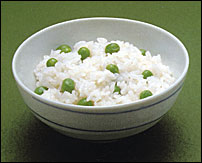
![]()
How to Cook Japanese Rice
One of the first questions non-initiates ask is, "How does it stick together like that?" The answer: It just does. The shorter the grain of rice, the higher the starch content, and the higher the starch content, the stickier the rice. The kinds of rice favored in Japan are all very short-grained--the shortest and stickiest, mochi, looks like tiny pebbles--and as a result, the only way to get cooked Japanese rice off your fingers is surgical removal. (So be careful.) Wetting down the rice does cause it to lose cohesion, but you tend to end up with rice slime. (So be careful.)
In America, Japanese rice sells for $12 to $25 for a ten-pound bag. You don't need to buy the most expensive brand to get good quality; all of the common brands--Hikari, Nishiki, and the like--are good. The discerning palate can pick out slight differences between them, though. Buy them in 5-pound bags and experiment until you find the one you like best.
The easiest way to cook rice is in a rice steamer. Top-end rice steamers, as sold in Japan and other places where people take their rice seriously, have several settings for different kinds of rice and can be set on timers, so that both your coffee and your rice are piping hot for you in the morning. Low-end rice steamers, as sold in Wal-Mart and other places where people take their screaming children, have a "cook" button. Personally, I've gotten great results from a $15 rice steamer. YMMV.
Your rice cooker will come with directions. Read them. Done? Good. Now READ THEM AGAIN. Done? Good. NOW you can read the rest of this page. The biggest mistake most gaijin make is in dumping a bunch of dry rice into the steamer, pouring some water on top, hitting the "cook" button, and shoveling rice onto their plates the minute the "cook" button pops up. Eating rice cooked this way is like eating a handful of popcorn full of old maids.
Real rice cooking involves several steps:
- Washing the rice.
- Soaking the rice.
- Cooking the rice.
- Aftersteaming the rice.
I'll go through these step by step.
- Washing the rice. The Japanese traditionally wash
their rice to purify the flavor and to remove any impurities remaining
in the dry rice. Modern mass-produced rice rarely has impurities, and
manufacturers sometimes add a light dusting of nutrients to replace
what was removed during production. Washing takes off this coating.
If you don't want to bother washing your rice, skip to the next step.
If you do want to wash your rice, place it in a pot and run water over
it, then swirl the rice with your hands to stir it up. Pour out the
milky water carefully and cover the rice with more water; repeat. Do
this until the water runs clear.
- Soaking the rice. Put the rice in the pot and add
the cooking water (about 1 1/4 cups of water to each cup of dry rice
if you didn't wash the rice, slightly less water if you did wash the
rice; experiment to find out how much water you need to get the right
texture). Let the rice soak until it has puffed up and is slightly softer.
I find that this generally takes 10-15 minutes, less if I've washed
the rice.
- Cooking the rice. Plug the rice cooker in--this will
automatically put the cooker on "warm"--then close the lid
and hit the "cook" button.
- Aftersteaming the rice. The cooker will go "click" or "ding" when it's done. Don't open the lid! Right now, the rice is half-cooked and runny. Let the cooker steam the rice on low heat for 10-15 minutes.
 Ta-da!
All done. Japanese rice is usually cooked plain, although you can add
a little salt or a few simple vegetables, like peas.
Ta-da!
All done. Japanese rice is usually cooked plain, although you can add
a little salt or a few simple vegetables, like peas.
Common wisdom has it that cooked rice will stay good at room temperature for one day. Your mileage will definitely vary. In the middle of a Boston winter, rice keeps for two days; in Louisiana, rice keeps for about eight hours and then starts going pink. My girlfriend used to have a mondo cool top-of-the-line rice steamer which would keep rice warm and happy for a couple of days, regardless of the weather, but then her roommate moved out and took the steamer, and now she's left with a cheap steamer which dries rice out in a couple of hours if it's left on. Experiment.
Unfortunately, putting the rice in the fridge is no solution. The cold destroys the starch and turns the rice into wee maggot-shaped pebbles. Some people say that you can revive the pebblefied rice by putting it back in the steamer with a little water, but I've had no success with this method. If you're stuck with too much rice, a better solution is to fry it. Add a raw egg or two, some soy sauce, a few veggies, and maybe some chopped meat, then stir-fry. The fried rice won't turn the deep brown of the fried rice you get at the local Chinese place (that takes a special, thick kind of soy sauce). However, it'll keep in the fridge without solidifying.